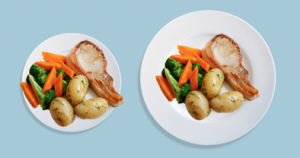My husband is the only person I know who stops eating when he is full. It’s incredible to watch really. When we go out to eat he has been known to take four or five bites of his food before pushing his plate away. As someone who is guided by visual cues, I usually end up cleaning my plate and then finish his food as well.
I am probably not alone when I admit that I often eat more than I intend to at any given meal. While I generally chalk it up to lack of willpower, I know that environmental cues play a subtle hand in my decision-making too. Most people are likely aware by now that the size of your plate can influence how much you eat – not just because you can fit more on a bigger plate. The white space between the food on a big plate makes your portions of food look smaller, telling your brain that you’ve eaten less than you really have.
I did a little research to see what other, less obvious, factors might trick our brains and our stomachs into consuming more than we need. Brian Wansink from The Food & Brand Lab at Cornell University has performed countless studies human eating behavior. He finds that:
- We pour more fluid without realizing it into short wide glasses than tall ones. Even seasoned bartenders are tricked by this.
- A cluttered chaotic environment (think: messy kitchen with a sink full of dishes, counters full of papers and gadgets) is a source of stress that leads to consuming more calories.
- We eat more food when it is packaged in larger containers, even when it is stale, 10 day old popcorn…
- While we actually eat fewer calories in dimly lit restaurant dining rooms, the food we do order tends to be less healthy.
- The more effort required to eat something, the less likely we are to consume it. (Shelled versus unshelled nuts, a candy dish that is on your desk versus on the other side of the office). This might explain why vegetable consumption is such a hurdle for so many individuals, as some vegetables require cooking, whereas fruit tastes better raw.

- Consumers are more likely to purchase a food item when it has a more colorful description on the label. (Think “New York Style Cheesecake” versus “Cheesecake”.)
- The color of your plate matters, as does your background music. Sweet flavors are often subconsciously triggered by round, white plates and higher-pitched music. Angular, dark plates and lower-pitched sounds bring out savory and bitter flavors. Red plates tend to reduce the amount of food we eat at a meal.The list does not end here.
The amount of food we eat, as well as our satisfaction with it, is also influenced by our moods (we eat more when we are bored or doing repetitive tasks), the weight of our dishware, and whether we’re alone or with company. Being mindful of these environmental cues is an important first step in taking control over what, and how much, we eat.
The silver lining is that we can take these same cues and use them to our advantage. I now use the short wide glasses from my cupboard whenever I drink water in order to subconsciously drink more. I eat my dinner on a salad plate, and my salad on my dinner plate to cue my brain to eat more vegetables. I make sure that I keep healthy snacks within reach when completing mindless tasks. Unfortunately for me, that “cheesecake” still sounds tasty, descriptive label or not. It’s all about the baby steps.
Don’t miss another great blog: Subscribe Now

My husband and I order from a menu based on leftovers for lunch the next day. We eat half and ask for a take out box.
These are some awesome tips. It is so good to be reminded of these things at this time of the year. By using these tips, last Thanksgiving and Christmas was the first time in my entire life that I did not gain weight during the holiday season. I hope to make this two years in a row! Now for me….that is an accomplishment!!!
WOW!! Karen that is a huge accomplishment, Congratulations!! And you can absolutely do it again this year– we are here cheering you on! We would love to hear if you use any of the tips listed above and how it goes for you. Some of them are so interesting.. the color of the plate for example. Who would have thought! 🙂
Even though I eat alone, I set a place at the table and eat with a cloth napkin and real dishes. I try to slow down, start with grace and enjoy the moment. I think I eat healthier that way.
That is wonderful, Valerie! That absolutely will help you to slow down, be more mindful, and enjoy your meal instead of flying through it- which can be easy to do when you’re eating alone! I have found to put on music or a podcast instead of the tv when I am eating alone helps me to not get distracted but to still have some “background noise”. 🙂 Thank you for sharing and keep up the GREAT work!